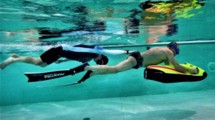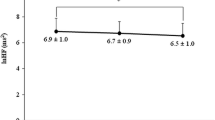Abstract
The present study investigated the mechanism of diving bradycardia. A group of 14 healthy untrained male subjects were examined during breath-holding either out of the water (30–33°C), in head-out immersion, or in whole-body submersion (27–29°C) in a diving pool. Blood velocity, blood volume flow in the carotid artery, diastolic blood pressure and electrocardiogram were measured and recorded during the experiments. The peak blood velocity increased by 13.6% (P < 0.01) and R-wave amplitude increased by 57.1% (P < 0.005) when the subjects entered water from air. End-diastolic blood velocity in the carotid artery increased significantly during breath-holding, e.g. increased from 0.20 (SD 0.02) m · s−1 at rest to 0.33 (SD 0.04) m · s−1 (P < 0.001) at 50.0 s in breath-hold submersion to a 2.0-m depth. Blood volume flow in the carotid artery increased by 26.6% (P < 0.05) at 30 s and 36.6% (P < 0.001) at 40 s in breath-hold submersion to a 2.0-m depth. Diastolic blood pressure increased by 15.4% (P < 0.01) at 60 s during breath-holding in head-out immersion. Blood volume flow, and diastolic blood pressure increased significantly more and faster during breath-holding in submersion than out of the water. There was a good negative correlation with the heart rate: the root mean square correlation coefficient r was 0.73 (P < 0.001). It was concluded that an increased accumulation of blood in the aorta and arteries at end-diastole and decreased venous return, caused by an increase in systemic peripheral resistance during breath-holding, underlies diving bradycardia.
Similar content being viewed by others
Author information
Authors and Affiliations
Additional information
Accepted: 22 November 1996
Rights and permissions
About this article
Cite this article
Pan, AW., He, J., Kinouchi, Y. et al. Blood flow in the carotid artery during breath-holding in relation to diving bradycardia. Eur J Appl Physiol 75, 388–395 (1997). https://doi.org/10.1007/s004210050177
Issue Date:
DOI: https://doi.org/10.1007/s004210050177




